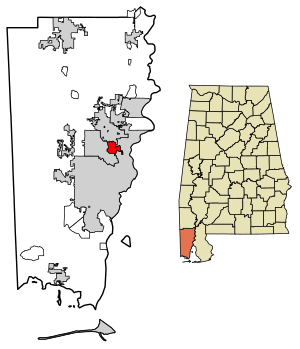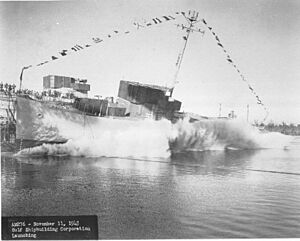Chickasaw, Alabama facts for kids
Quick facts for kids
Chickasaw, Alabama
|
||
|---|---|---|
|
||

Location in Mobile County, Alabama
|
||
| Country | United States | |
| State | Alabama | |
| County | Mobile | |
| Area | ||
| • Total | 4.56 sq mi (11.80 km2) | |
| • Land | 4.21 sq mi (10.89 km2) | |
| • Water | 0.35 sq mi (0.91 km2) | |
| Elevation | 30 ft (9 m) | |
| Population
(2020)
|
||
| • Total | 6,457 | |
| • Density | 1,534.82/sq mi (592.66/km2) | |
| Time zone | UTC-6 (Central (CST)) | |
| • Summer (DST) | UTC-5 (CDT) | |
| ZIP codes |
36611, 36671
|
|
| Area code(s) | 251 | |
| FIPS code | 01-14392 | |
| GNIS feature ID | 0116030 | |
Chickasaw is a city located in Mobile County, Alabama, in the United States. In 2020, about 6,457 people lived there. It's part of the larger Mobile metropolitan area, which is a big group of cities and towns around Mobile.
Contents
History of Chickasaw
How Chickasaw Started as a Company Town
Before Chickasaw became an official city, it was a special kind of place called a company town. This means one company owned everything. The Chickasaw Shipyard built this town for its workers in the early 1900s.
Later, in 1940, Gulf Shipbuilding Corporation bought the property. The town grew a lot during World War II because more ships were needed for defense.
There was even a famous court case about Chickasaw. In 1946, the Supreme Court of the United States decided that even though the town was privately owned, people still had their basic rights there. This meant visitors and residents could express themselves freely, just like in any public town.
In 1946, a company called Leedy Investment Company bought the village. They fixed up the houses and sold them to people who used to rent them. Some former residents even moved back and bought their homes. However, when shipbuilding slowed down, many jobs were lost.
To remember its unique past, the Chickasaw Shipyard Village Historic District was added to the National Register of Historic Places in 2004. This helps protect its history.
Geography of Chickasaw
Chickasaw is in the eastern part of Mobile County. It is next to the city of Mobile on the east, Prichard to the south and west, and Saraland to the north.
U.S. Route 43 is a main road through Chickasaw. It goes south about 5 miles to downtown Mobile and north about 60 miles to Jackson. Interstate 65 also passes through the west side of Chickasaw. You can get on I-65 from Exit 10 (West Lee Street). This highway goes south into Mobile and northeast to Montgomery.
The city of Chickasaw covers about 4.56 square miles. Most of this is land, but about 0.35 square miles is water. Chickasaw Creek, which connects to the Mobile River, forms the city's northeast border. The Port of Chickasaw is located on Chickasaw Creek.
Population Changes in Chickasaw
| Historical population | |||
|---|---|---|---|
| Census | Pop. | %± | |
| 1950 | 4,920 | — | |
| 1960 | 10,002 | 103.3% | |
| 1970 | 8,447 | −15.5% | |
| 1980 | 7,402 | −12.4% | |
| 1990 | 6,649 | −10.2% | |
| 2000 | 6,364 | −4.3% | |
| 2010 | 6,106 | −4.1% | |
| 2020 | 6,457 | 5.7% | |
| U.S. Decennial Census 2013 Estimate |
|||
Chickasaw had its largest population in 1960. This was when the shipyard was very busy. Since then, fewer jobs in shipbuilding have caused the population to decrease.
What the 2010 Census Showed
In 2010, there were 6,106 people living in Chickasaw. There were 2,430 households, and 1,612 families. The city had about 1,388 people per square mile.
- About 63.0% of the people were White.
- About 33.6% were Black or African American.
- About 0.8% were Native American.
- About 0.5% were Asian.
- About 2.3% of the population were Hispanic or Latino.
About 29.2% of households had children under 18. The average household had 2.51 people. The average family had 3.12 people.
The median age in the city was 35.1 years old. About 26.9% of the population was under 18. About 14.8% were 65 or older.
The median income for a household was $33,061. For families, it was $40,625. About 20.7% of the population lived below the poverty line.
What the 2020 Census Showed
| Race | Number | Percentage |
|---|---|---|
| White (non-Hispanic) | 3,153 | 48.83% |
| Black or African American (non-Hispanic) | 2,760 | 42.74% |
| Native American | 36 | 0.56% |
| Asian | 27 | 0.42% |
| Pacific Islander | 1 | 0.02% |
| Other/Mixed | 291 | 4.51% |
| Hispanic or Latino | 189 | 2.93% |
As of the 2020 United States census, there were 6,457 people living in Chickasaw. There were 2,134 households and 1,246 families.
Education in Chickasaw
Chickasaw has its own public school system, called Chickasaw City Schools. In 2012, the city decided to create its own school district. This meant it left the system run by the Mobile County School Board.
History of Schools in Chickasaw
Before 2013, Chickasaw's public schools were part of the Mobile County Public School System. Hamilton Elementary School was in Chickasaw and served local students. There were also two special magnet schools in the city: the elementary Chickasaw School of Mathematics and Science and the Clark School of Mathematics, Science and Technology (a high school).
Around 2009, Chickasaw officials thought about leaving the Mobile County school system. This happened after Mobile County considered closing the magnet schools in Chickasaw. These magnet schools had only about 14% of their students from Chickasaw. The rest came from other areas.
Chickasaw officially separated from the Mobile County school system in 2013. The elementary Mathematics and Science school was later moved to a different location near Downtown Mobile.
Famous Person from Chickasaw
- Ray Sawyer was a singer in the band Dr. Hook and the Medicine Show. He was born in Chickasaw in 1937.
See also
 In Spanish: Chickasaw (Alabama) para niños
In Spanish: Chickasaw (Alabama) para niños



